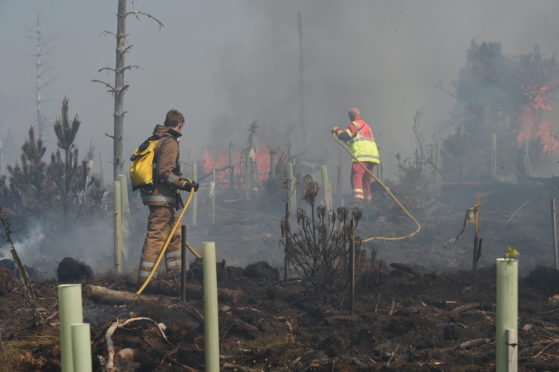Fire bosses say an extraordinary eight-fold rise in the time they spend battling wildfires because of climate change and other factors shows how urgently they need more resources.
Exclusive new figures have underlined the way wildfires are “stretching” the resources of the Scottish Fire and Rescue Service (SFRS).
Official data, released to The Press and Journal, shows that there has been 750% increase in the time spent battling wildfires in the last decade, up from 626 hours in 2009/10, to 5,332 hours last year.
Helicopters were drafted in to assist in two huge wildfires in the north of Scotland earlier this year, and fire chiefs are now demanding such support is more readily available.
Senior firefighters are seeking talks with the Scottish Government to try to strike a new deal on access to helicopters so areas can be more quickly water-bombed.
Currently the service relies on the insurance of landowners to pay for helicopters, but now wants to discuss options for a “smarter” solution given the increased frequency of such blazes.
According to the figures, wildfires in the Highland Council area alone took up 1,892 hours last year – by far the highest in Scotland, and up from 971 in 2017/18, and 308 hours in 2016/17.
Moray was the next highest in nation, with 731 hours spent tackling wildfires last year – more than the combined total in the area for the preceding nine years.
West Lothian had the third most time-consuming wildfires, at 392 hours, followed by 380 in Fife, 307 in Aberdeen City, 275 in Edinburgh and 233 in Aberdeenshire.
And this year is shaping up to be even worse, with just two fires near Forres and by Thurso already estimated to have equalled the total area burnt by wildfires in the entire UK last year.
The actual number of wildfires has also more than doubled, from 94 in 2009/10 to 194 last year.
“They are getting more common. They definitely are going up,” said SFRS area manager Bruce Farquharson, who is also the chairman of the Scottish Wildfire Forum.
“There are a number of reasons. Some of it is climate change. In fact, I would say a lot of it is climate change.
“We’re getting colder drier winters and warmer springs. So all that contributes to the ideal conditions for wildfires in spring.
“We’ve also got other systems at play. Muirburn (controlled burning) activity not taking place as frequently as it used to means there is a lot more fuel there to burn. The fire breaks aren’t in place.
“Muirburn actually removes the fuel and introduces fire breaks, so when that doesn’t happen there is more fuel to burn and it can burn unchecked, because there is no stop for it to get to.”
Mr Farquharson was incident commander when one of the largest such blazes in the UK for years spread over 32 sq miles in Knockando, Dallas and Dunphail in April, and it was followed in May by another wildfire that covered about 34.7 sq miles near Thurso.
“When we get wildfires it definitely does stretch the service,” he said.
“At no point does it not allow us to respond effectively and efficiently to other incidents, but what it does require is a large number of people, for quite a protracted period, working very hard to extinguish the fire.
“I need to stress, we don’t do that in isolation. We work really, really closely with colleagues in the land management sector, gamekeepers, farmers, to help us with that. Without their help, we would struggle. So that help is invaluable.”
Mr Farquharson revealed the service was seeking more help from the Scottish Government to cope with the rising demand on resources.
“All I would say is we’re seeking to engage with the government to see if resources can be made available to assist with operations. In particular, the provision of helicopters,” he said.
“Certainly different strategies will be required, because there are different ways of dealing with fires, using different methods that can be quite cost-effective.
“Helicopters is definitely one. It’s called aerial bombing and it’s effectively dropping water onto specific locations to put the fire out.
“The fire service doesn’t own helicopters. What we rely on at the moment is landowners having insurance that will cover the cost of the hire of helicopters.
“So we’re trying to see if we can get a bit smarter around about that, and see what other opportunities are available to us.
“Because the real key thing with the helicopters is getting them out quickly, getting the out early, and making a rapid intervention.”
For the first time, fire chiefs are also poised to authorise the use of controlled burning to try to stop the spread of a wildfire when it erupts.
“We’ve discussed with other countries around that world that have a wildfire problem and see how they deal with it, and gamekeepers to see how they deal with muirburn,” said Mr Farquharson.
“And what we’re looking to incorporate in the future, it’s still part of a strategy that is being developed, it’s not actually been approved yet, is the use of fire.
“So we would actually burn back against the wildfire with a controlled fire, to put it out.
“It’s not a new technique, but it would be in Scotland.”
